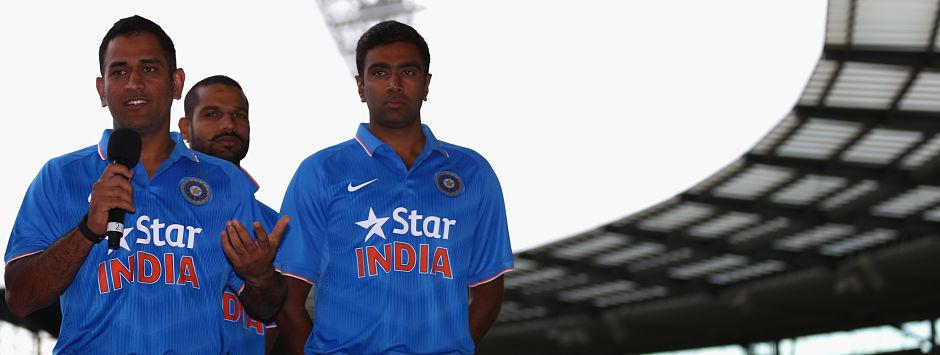Two Questions India Need to Answer During the Tri-Series in Australia
With the India-Australia-England tri-series starting tomorrow, it is time to put aside Virat Kohli’s brave new world and turn our attention back to MS Dhoni’s brave old world.
Dhoni may have used up his street cred in the five-day game but his magic is still very much alive in the 50-over format. And if the pitches remain as batsmen friendly as they did for the Test series, India will have a good chance of winning the tournament.
But winning is only one of the goals. India will be using the tournament to figure out their best playing XI for the World Cup that follows. Here are two questions the team should use the tri-series to answer:
1) What is Inda’s best opening combination?
Despite being dropped from the Test XI, Shikhar Dhawan is a shoo-in as one opener. He has been India’s most consistent ODI batsmen after Virat Kohli. Who partners him comes down to a choice between Rohit Sharma and Ajinkya Rahane. Over the last 12 months, Rohit has averaged 52.54 from 12 matches while Rahane has averaged 32 from 24 matches. But take away Rohit’s blistering world-record 264 and his average drops to 28.54. Likewise, bump Rahane up to opener and his average bumps up as well – to 37 from 15 innings.
Beyond the numbers, the two offer very different playing styles. Rahane is an accumulator; Rohit a plunderer. Rahane can keep the scoreboard busy with ones and twos. Rohit prefers a feast or famine approach – often consuming a large number of deliveries early in his innings without scoring.
India will have to mix and match to find out which approach works better in Australian conditions.
The other side of the question is where to play Rohit or Rahane if they are not opening. With Kohli likely to bat at No. 3, that leaves the No. 4 spot as the likeliest option, with Suresh Raina at No. 5, followed by Dhoni.
If Rahane or Rohit struggle down the order, India have Ambati Rayudu, who had a fantastic series against Sri Lanka, hovering in the wings.
2) What is India’s best bowling combination?
Picking the bowlers is a much trickier task. The statistics argue India have to choose between wickets and economy. For example, Mohammed Shami’s strike-rate over the last 12 months is 22.3 but he goes for 6.16 runs an over. In contrast, Bhuvneshwar Kumar has conceded just 4.62 runs over the same time span, but his strike-rate is 58.8.
Similarly, Umesh Yadav’s strike-rate is 25.1 but is economy rate is 5.34.
India will have to figure out the risk-reward ratio that works for them because these bowlers aren’t going to morph into world beaters over night. To borrow a phrase, they are what they are.
Shami probably has to play. His 38 wickets over the last year are the best by some distance. Ravindra Jadeja is next with 25. Bhuvneshwar also probably has to play, both for the control he gives Dhoni and for his bat.
The injury to Ishant leaves Umesh Yadav and Mohit Sharma to duel for the third seamer’s sport.
Even though Umesh did well against Sri Lanka, he had a disastrous Test series and his abysmal performance in the final Test in Sydney should force him back to the bench. Let Mohit have a run in the side while India work on Umesh’s bowling in the nets. If Mohit ends up getting tonked, India potentially have a somewhat improved Umesh in reserve. If that sounds like a hedge, that’s because it is a hedge. At this point, Umesh’s ability to learn and adapt is unconfirmed.
When it comes to the spinners, in the absence of Jadeja, Akshar Patel should be the first name on the team sheet. This is a great opportunity for Akshar to prove himself away from home. If he succeeds, India would have found another arrow in its quiver for the World Cup, even when Jadeja returns from injury. If he fails, there is the more experienced Ashwin to fall back on.
The final question is whether to play a seam bowling allrounder or a spinning allrounder. The obvious answer is to let conditions dictate that choice. If the pitch looks like helping the spinners, play Ashwin. If it looks like helping the seamers, play Stuart Binny. India should not be bogged down by a formula.
The problem is the way Dhoni has treated Binny so far in his short international career suggests Binny is there as a result of elimination rather than belief – there simply isn’t another option.
But if there is no one else, what’s wrong with throwing Binny in to the fray from the start? India need to find out if he can do a job for them before the World Cup rather than be forced to use him during the tournament without knowing what he can do. After all, there is nothing to lose and crucial flexibility to be gained.
Source: FirstPost.com

